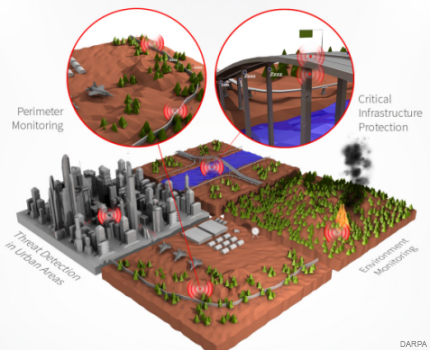Pentagon's near-zero power plan could change the game for wireless sensors
DARPA's N-ZERO program would make devices that lie dormant but aware until triggered by a specified event.

An artist’s concept of N-ZERO sensors in use.
A problem with the Internet of Things, whether in a military or civilian environment, is that all of those Internet-connected devices require power. And if they’re not plugged in, that power comes from batteries that will run out pretty quickly, which means regularly replacing or recharging those batteries in a process that is time-consuming, costly and, in military situations, dangerous.
Pentagon researchers are looking to change that scenario with sensors that essentially hibernate, lying dormant but aware while using almost no power, until triggered by a specified event. If successful, the program could extend the lives of battery-powered sensors from months to years, not only improving sensing capabilities on the battlefield or other military environments, but making devices such as wireless bridge sensors or environmental monitors more feasible.
The Defense Advanced Research Projects Agency’s Near Zero Power RF and Sensor Operations, or N-ZERO, program wants to develop the underlying technologies for passive monitoring that could let batteries last up to a thousand times longer than they do now while reducing the size of those batteries by a factor of 20 or more.
“It is the waiting for a specific event or activity that constrains mission life and drains the battery energy of these essential electronics,” Troy Olsson, DARPA program manager, said in a release. “By cutting reliance on active power and enhancing battery life, N-ZERO aims to enable wireless, ubiquitous sensing that is energy efficient and safer for the warfighter.”
Current military sensors are persistent, meaning they operate continuously, even when intended to monitor for events that don’t happen very often. Not only does that drain battery life, but it also means that they’re usually sending information that is of no interest. With N-ZERO, DARPA wants to develop sensors that, at rest, use less than 10 nanowatts of power until brought to life by a signature they’ve been programmed to notice, such as a specific radio-frequency signal or the presence of a specific type of vehicle.
The program initially is focusing on RF, electromagnetic, acoustic, and inertial detection and analysis sensors used in two broad areas: unattended ground sensors that would monitor infrequent events in the physical environment and radio receivers that respond to friendly radio frequencies. The goal is exploit the energy in the signal signature itself (a type of vibration or radio signal, for instance) to detect and identify the preferred signature, “while rejecting noise and interference,” according to a presolicitation issued in January. In urban environments, DARPA wants to hold the false-alarm rate down to about one per hour.
DARPA intends to use the sensors in situations such as battlefield engagements, infrastructure monitoring and border protection, but N-ZERO sensors could also have much wider applications. They could be used to identify cracks in bridges or changes in the ecosystem, particularly in remote areas where power sources couldn’t be tended to regularly, DRAPA said. They also could add a new wireless element to other elements of the Internet of Things, the worldwide network of connected devices (everything from heart monitors to refrigerators) that is expected to reach 30 billion devices by 2020.
Full proposals to DARPA’s solicitation are due by April 23.